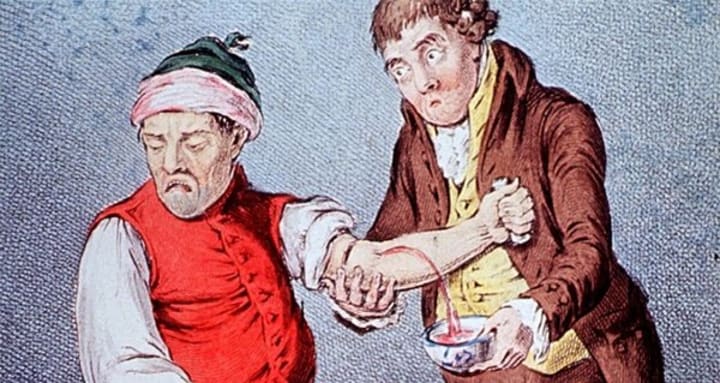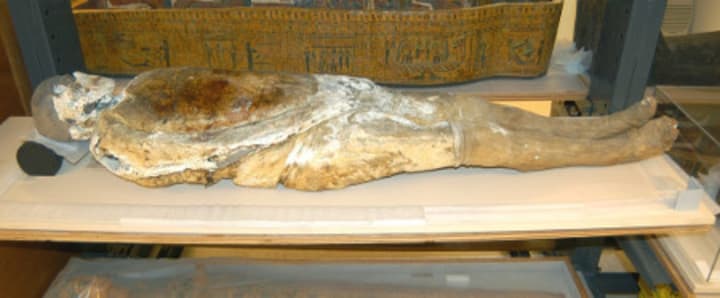Bizarre Medical Practices from the Past
A Curious Look at Antiquated Methods

The world of medicine is constantly changing. Things once thought to be amazing breakthroughs are now regarded as harmful and sometimes even obscene. Let’s explore the exciting and sometimes disturbing approaches that have been utilized throughout the centuries.
Goat Testicles

In the early 20th century John Brinkley became one of the richest doctors in America by implanting goat testicles into male scrotums. As strange as this may sound, the Kansas surgeon had so much demand over the years that he ended up becoming a millionaire, while the average doctors’ salary at the time was only $3,500.
The procedure was said to be the solution to nearly any male ailment including virility, infertility, and even incurable illnesses. The very first person he performed it on ended up with a son nine months later, which was named Billy, after the goat. The miraculous story of the man’s fertility reviving after having a goat testicle sown into him quickly got around, resulting in Dr. Brinkley having an unprecedented surge of patients. He ended up keeping a supply of goats on hand so that patients could personally pick out which one they wanted as their donor.
Needless to say, arbitrarily inserting goat testicles inside a man’s scrotum ended up having some negative effects. After nearly two decades of Brinkley carrying out the unconventional treatment, the Kansas medical board decided to examine the situation. Upon discovering that Dr. Brinkley had signed over forty-two death certificates, they made the decision to revoke his license. Nevertheless, he still had many former patients who stood by the treatment and respected him, prompting him to run for governor of Kansas in the hope of renewing his license, however he lost the election.
Tobacco Smoke Enema

The procedure of literally blowing smoke up one’s ass was widely used in the 17th and 18th centuries. These tobacco smoke enemas were said to treat such maladies as colds, headaches, typhoid fever, and cholera; even being utilized in resuscitation attempts. This idea seemed to originate from Native Americans who were known to use smoke enemas regularly, often for spiritual reasons or to aid in respiratory simulation. Word of the treatment quickly got back to England raising many curiosities.
One of the best-known cases of its use as a documented medicinal tool was in 1746. A man held his wife who had drowned when a passerby offered him his tobacco pipe and told him to insert the pipe’s stem in her rectum. He was then instructed to cover the other end of the pipe with his mouth and blow hard. Amazingly the woman regained consciousness, and word ended up getting around causing this became a frequently used technique on drowning victims.
The effectiveness of this tobacco treatment died out as more proponents spoke out against it. King James I, said he did not believe it to have any positive effects and deemed it a farce. Prompting the modern saying, “To blow smoke up one’s ass”. In 1811, scientist Ben Brodie claimed that nicotine was actually extremely toxic to the heart, from there the use of smoke enemas wafted away.
Old School Rhinoplasty

Upon syphilis’s arrival in Italy in the 16th century ‘saddle-nose’ started to become a problem. This was an unfortunate malady brought on by the disease in which the bridge of the nose collapses. Italian surgeon, Gaspare Tagliacozzi instituted an awkward method, in attempts to assist his patients in concealing their nasal deformities. He would create a new nose using tissue from the patient’s underarm. Then he would cover the nose with a flap of skin from the upper arm, all whilst it was still cumbersomely attached to the arm. After about three weeks the skin graft was thought to be firmly attached, so Tagliacozzi would disconnect the skin from the limb.
Whilst the procedure seemed to work reasonably well, some did not have the ideal results. There were several reports of people’s noses turning purple and falling off during especially cold weather. The procedure was eventually abandoned as cures for syphilis were discovered and the practice of rhinoplasty evolved.
Trepanation

This procedure compromised of putting holes in the skull via drilling, cutting, or scraping. This intrusive procedure was utilized to treat a wide-range of medical conditions, sometimes even being used for mystical purposes. The treatment was largely praised in the 16th century, with evidence of trephined skulls having been found in nearly every part of the world.
It was most commonly used for head injuries, migraines, epilepsy, and mental illness. A 13th century medical text recommended placing holes in the skull of epileptics so “that the humors and air may go out and evaporate.” In regards to mental illness they believed similarly, that it was caused by noxious materials gathering in the head and that trepanation would exhale them to the outside. Others still believed that it could expand your consciousness and was often said to enhance the effects of psychedelic drugs.
The process of trepanation was so dangerous that nearly half the people whom received it perished. Nonetheless it continued as an accepted medical practice until the early 19th century, when many people began to have medical procedures done in hospitals rather than at home. There ended up being such high mortality rates in hospitals because of it, that they ended up disallowing the procedure altogether.
Bloodletting

The practice of withdrawing blood from the patient’s veins, also known as phlebotomy, was a therapeutic technique used for various maladies for thousands of years. It is regarded as one of the oldest medical practices, having been practiced as far back as ancient Egypt. Physicians used an assortment of instruments to carry out this practice, ranging from rustic scalpels, sharpened wood or even ‘sacrifactors’ which were tools with multiple blades. The patient would then bleed from the gashes into cups. Leeches were also commonly employed in this practice if readily available. The goal was to empty the body of as much blood as possible in order to purify the body of any toxins or diseases that may have been present.
This method was utilized if a patient complained of such problems as excessive phlegm, bile, or even fatigue. In Medieval Europe it become a standard treatment for viruses such as smallpox, epilepsy, gonorrhea, and gout. Respected physicians and nobles indorsed and valued the practice. Once, Marie Antoinette underwent a bloodletting after falling unconscious after childbirth. It is said she immediately revived and lived vivaciously for fourteen more years until finally perishing upon the guillotine.
Bloodletting was not only used as a method to treat illness but was also touted as a preventative measure. Purging the blood was thought to cool and ventilate the patient’s core, being beneficial towards a seasonal change or even an upcoming menstruation. Some doctors believed it to be necessary, as they thought that stagnant blood, such as stagnant water, was toxic. They reasoned it might decay and turn to pus, therefore the justification for bloodletting, to let the blood flow out before it spoiled.
In ancient Mayan culture bloodletting was used in ritual sacrifice in attempts to speak their gods and royal ancestors. It was often combined with fasting, hallucinogens, tobacco smoking, and ritual enemas; all undertaken to incite a trance-like state, or altered consciousness. They often did this on special dates of the Mayan calendar and used accessible tools such as stingray spines and obsidian blades. Evidence suggests that bloodletting in all its various applications, was widely used in many cultures throughout the world up until the 19th century.
Animal Dung Remedies

The belief of animal dung holding various medical properties reaches back all the way to ancient Egypt. One of the earliest applications was utilizing crocodile dung as a form of birth control. They would mix the dung with honey forming it into a type of putty and insert it before intercourse. It may sound outlandish but the dungs acidic properties were known to behave as a spermicide, with the honey’s antibacterial advantages preventing infections.
There were seemingly endless options in the world of medicinal animal dung, ranging from concoctions made from gazelles, rats, and even elephants, each renown for its specific properties. Sheep dung for example, used internally was said to relieve jaundice, while externally was touted as a cure to warts. In the case of swelling and pain, a poultice of cows’ dung was crafted to be wrapped around the affected area.
Although the medicinal use of dung mostly died out in the 19th century, some still swear to its uses today. A Chinese woman recently attributed the drinking of a cow and goat dung mixture to curing her advanced lung cancer. While the modern Fecal Transplant Foundation specializes in the procedure of human dung transplants, said to heal ailments ranging from Irritable Bowel Syndrome to Clostridium difficile.
Corpse Medicine

An elixir often containing a ratio of human flesh, blood and bone was a customary cure for several centuries. The concoction varied based on the ailment being treated, such as crushed skull for migraines or human fat for muscle aches. King Charles II was known to enjoy an occasional swig of ‘King’s Drops’, a supposedly healing beverage amassed from crumbled human skull and alcohol. While the Romans held the speculative belief that the blood of fallen gladiators could cure epilepsy.
In the 12th century apothecaries often carried a unique remedy known as ‘mummy powder’, originally having been derived from ground up mummies that had been plundered from Egypt. In later years the bodies of recently deceased criminals were commonly utilized in such mixtures. The powder was believed to alleviate many complaints ranging from cough, stomach ulcers, and headaches.
Many also believed these corpse medicines to contain magical properties. One example being that the deceased passed a piece of their spirit onto the consumer, resulting in increased vitality and rigor. Sometimes the very ill would attend executions in the sole hope of receiving an inexpensive cup of fresh blood from the slain. Corpse medicine remedies widely fell from popularity in the 18th century as sentiments towards consuming human remains greatly shifted.
The Rest Cure

The outlandish practice of forcing a woman to remain lying down for several months whilst consuming fattening foods was unfortunately widely used in the 19th century. Dr. Silas Weir Mitchell enthusiastically advocated for his strict “rest cure” regime. This compromised of taking women who seemingly had mental distress and putting them into isolation for six to eight weeks, in which they were forbidden from reading or any other activities, and made to devour copious amounts of milk, butter, and other fatty foods. They were not allowed to sit up unless they were actively eating or relieving themselves.
He suggested that women at the time were venturing out of the house more often and doing such things as reading or painting which was too strenuous on their feeble minds and bodies. He reasoned that by disallowing them to use their brains and muscles for a period of time, they would be able to recover. He also believed thinner women were more likely to be delirious, therefore the reasoning for the fatty diet. When problems with muscle atrophy arose, the doctor attempted to resolve them by sending in nurses to administer rough massages, or alternatively stimulating the muscles by electroshock.
When men had a similar diagnosis of hysteria or ‘nervous energy’ Dr. Mitchell alternatively recommended them to ‘Go West’. Which included such advice as chopping wood, cooking mannish meals over a campfire, wrangling animals, and so forth. The men often found this treatment to work wonders on their health. Unfortunately, several of the women on the ‘rest cure’ had opposite effects, often developing muscle or digestive issues, and succumbing to severe depression. Many women underwent this treatment, including the author Virginia Woolf. Although Dr. Mitchell adamantly defended the practice throughout his career, a quote from the closing of his book provided additional insight into his thoughts on the treatment.
“I am now more fearful that it will be misused, or used when it is not needed, than that it will not be used, and with this word of caution, I leave again to the judgement of time and my profession.”
Red Hot Pokers

Medieval physicians would often treat patients suffering from hemorrhoids by literally burning them off with cautery irons. This practice was just as painful as it seems, but without alternative treatments for hemorrhoids it was commonly carried out. It was supposedly adopted after an Irish monk suffering from hemorrhoids sat on a hot stone that miraculously cured him. In medieval times the condition of hemorrhoids was known as ‘St. Fiacre’s Curse.’
The traditional method for ridding of St. Fiacre’s Curse was to fill one’s anus with a red-hot poker iron until the hemorrhoids burned and exploded. For more extreme cases up to eight pieces of iron would be heated and maneuvered about until the hemorrhoids separated from the skin. People who wanted to avoid such unpleasantries would attempt a lesser used method, which involved pouring boiling pee onto the affected area, but this technique seemed to have little success. As alternative treatments for hemorrhoids emerged, this practice was quickly brought to an end.
Urine Tasting

The idea of analyzing urine to determine various ailments and diseases still survives to this day. However just a couple centuries ago, it was quite common for doctors to make a diagnosis by actually drinking a patient’s sample. This was combined with a thorough ‘urine wheel’ that offered explanations for different notes, colors, and viscosities.
It was often taught that if the urine tasted awfully sweet and was the color of straw with a green tint that the patient was suffering from diabetes. Whilst if it tasted like cream and was rather cloudy it could be a sign of neurotic issues or a bacterial infection. Alternatively, if it tasted very sweaty and footlike with a brownish color, it would likely be deemed a case of ‘Sweaty Feet Syndrome’.
Seemingly the diagnoses were often accurate, causing this practice to be carried out for thousands of years. Luckily doctors were able to leave this unpleasant diagnostic tool behind, as the invention of chemical analysis in the late 19th century took its place.
Radium Water

This disturbingly recent occurrence of radium being promoted as a cure all ended in adverse effects for decades to come. The scientific community believed that they had come across the holy grail upon discovering radium, an element that didn’t seem to follow the laws of physics. An experiment on it’s anti-aging properties was conducted in 1911, and by 1913 newspapers were promoting radium water.
Doctors started to prescribe the elixir for a wide-range of concerns, including arthritis, high-blood pressure, and even acne. Radium also found its way into breads, chocolates, and toothpastes. How this all happened is difficult to ascertain, as not all people were oblivious to radium’s dangers. In the factories where radium was handled, workers knew to wear protective gear such as lead aprons and other safety equipment. Various people attempted to come forward telling of gruesome side effects or deaths that had befallen family members, friends, or themselves, but they were hastily brushed off. Apparently, people were too anxious to attempt to reap the alleged benefits of the new remedy rather than heed any warnings.
Not until several years later, when a wealthy and well-known American, Eben Byers, suffered from its effects did people take notice. After injuring his arm, he was prescribed the deadly elixir by his doctor who insured him it would help heal it. Within two years he was dead, his jaw having rotted off and several abscesses on the brain. Being a prominent figure, his death was difficult to ignore, and the Federal Trade Commission finally took action to begin banning radium. Unfortunately, the damage had been done, and people would continue to lose teeth, develop inexplicable illnesses, and perish from cancer for decades to come.
About the Creator
M.R. Cameo
M.R. Cameo generally writes horror, sci-fi, fantasy, and nonfiction, yet enjoys dabbling in different genres. She is currently doing freelance work for various publications.






Comments
There are no comments for this story
Be the first to respond and start the conversation.